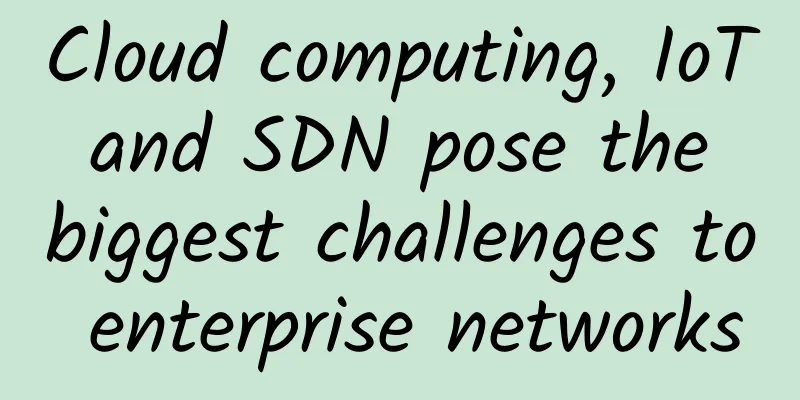Cloud computing, IoT and SDN pose the biggest challenges to enterprise networks

|
According to a new report released by Kentik, cloud computing adoption remains the most vexing factor causing network complexity. The survey report is based on a survey of 203 IT professionals attending Cisco Live 2017. Cloud computing ranked first, followed closely by IoT, SDN and network function virtualization (NFV). The report shows that even though machine learning is considered an "important technology for network management," most organizations are still not ready for network automation through machine learning. More than a third (36%) of respondents said cloud computing has created the greatest network complexity for their organizations, but there is still room for improvement in operational visibility of cloud computing and digital business networks. The report shows that organizations need to do a better job of detecting DDoS attacks, with a third (32%) of respondents saying they are using DDoS detection technology.
Most organizations (70%) say they use the same tool stack to manage network performance and security, which is hampering operational efficiency to some extent. However, more than half of respondents (59%) said their organizations are not yet using the same tools. “Dozens of our largest users tell us that the industry is currently divided on the ability of intuitive systems and emerging machine learning to monitor, identify, and react to network conditions before problems occur,” said Avi Freedman, co-founder and CEO of Kentik. “Recent survey results from Cisco Live show that key business priorities for 2016 and 2017 are gaining full visibility into the complexity of hybrid networks; detecting and preventing DDoS; and integrating tools that can deliver operator and business value from network analytics. Full automation outside of constrained data center and cloud topologies remains a user vision, but network operators say they need a deeper and more comprehensive view of network performance and security to make their networks autonomous.” "Real-time network traffic intelligence is a key indicator for network operators to support their digital transformation," he said. |
>>: 10 good ways to optimize mobile pages for developers
Recommend
2022 UBBF | Huawei iMaster NCE promotes FTTR intelligent monetization
[Bangkok, Thailand, October 28, 2022] Recently, t...
Talk丨Can positioning become a new growth point for LoRa technology?
First, an example: If you and your good friend ma...
The 30th anniversary of Zhongchuang Software: persistence and perseverance have created glory, and Xinchuang has provided broad space for independent innovation of middleware!
Since 1991, Zhongchuang Software Engineering Co.,...
5G interface protocol: from CPRI to ECPRI
In the architecture of early 2G and 3G base stati...
DogYun National Day Promotion: 30% off on Elastic Cloud, 20% off on Classic Cloud, 10 yuan free for 100 yuan recharge, buy 1 month and use 2 months on dedicated server
DogYun has launched a promotion during this year&...
The number of 4G users of the three major operators is nearly 1.3 billion, and the total number of fixed-line broadband users is 476 million.
Data released by the Ministry of Industry and Inf...
Maxthon Hosting 20% off on all VPS: US/Hong Kong/Germany/Netherlands CN2 line 2G memory package starting from 54.4 yuan per month
Maxthon Hosting still offers a 20% discount code ...
RAKsmart New Year's Big Offer: Cluster Servers Starting from $142/month, Available in Los Angeles/San Jose/Japan/Hong Kong Data Centers
RAKsmart is a Chinese-owned computer room, provid...
Hengchuang Technology: Hong Kong cloud server starts from 32 yuan/month, buy 2 months of dedicated server and get 1 month free
Hengchuang Technology (henghost.com) has released...
How to enable owners and facility managers to realize smart buildings
Building owners and facility managers are turning...
Gartner predicts: Global 5G network infrastructure revenue will grow 39% in 2021
[[416317]] Beijing time, August 9th, according to...
SpikeTel: $2.45/month-1 core AMD EPYC 7402P/1GB/20G SSD/1TB/Hong Kong VPS
SpikeTel is a new merchant, mainly providing Hong...
China Academy of Information and Communications Technology interprets the "Notice on Promoting the Accelerated Development of 5G"
In order to thoroughly implement the spirit of th...
MWC19 Shanghai | Ruijie and the operator industry jointly create a 5G world
[[268489]] Mobile communications, starting with G...
Millimeter wave and Sub-6GHz complement each other and empower various industries
At present, promoting the development of 5G milli...


![[6.18] DediPath: $30/month-E3-1240v2, 16GB memory, 2TB hard disk, 1Gbps unlimited traffic/Los Angeles data center](/upload/images/67cabe6780a9e.webp)






